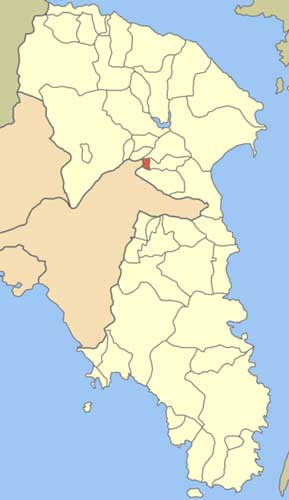.

Drosia (Greek: Δροσιά meaning cool, dew) is a rather exclusive suburb in Attica, Greece -- just about 22 km north of Athens. Since the 2011 local government reform it is part of the municipality Dionysos, of which it is a municipal unit.[2]
Drosia is a mainly residential suburb, known for its location in the midst of evergreen pine forests. During the extreme heat of Greek summers, many Athenians drive up to Drosia on the weekends, seeking cool and shade in the taverns, cafes and one outdoor cinema theater, for which the area is known.
Geography
Drosia sits between the Athenian plain and the Penteli mountains. The plain is to the west, the forests of the mountains that are bound with the mountain north of Penteli are to the east. Drosia is bounded by the Megali Diktyo , as well as the agglomeration to the south, and accessed via an interchange with GR-1/E75 (Athens - Lamia - Thessaloniki) at the 21st km near Varympompi 3 km west. The Cephissus River lies to the west. The main avenues are Leoforos Marathonos, and Grigoris Lamprakis Street connecting to the nearby communities of Dionysos and Rhea, and the area is located SE of Thiva, S of Euboea and Oropos, W of Marathon, NE of Kifissia and NE of the Attiki Odos (number 6).
History
Drosia was first known and founded only during the Greco-Turkish War of 1919-1922, formerly mainly composed of farmlands. Its first inhabitants were from Pontus and Asia Minor , and many of them could not head to Athens and Piraeus. The area was first named Rodopoli (Ροδόπολις, then as Rodopolis) in 1926 and was part of the community of Stamata, and the area of the settlement bordered with the authentic Bogiati (Μπογιάτι) ,which is now Anixi, and Neo Bogiati (Νέο Μπογιάτι), which is now Agios Stefanos. One neighbouring settlement of Stamata was the ball which adopted the name of the ancient city Rodopolis, the modern Drosia; a couple of years later, it adopted the name Rossochori or Roso(c)hori (Ρωσσοχώρι). The name was in use until 1952, when it the city was recreated according to a triangular plan, and was renamed as the present Drosia.
Until the 1960s and the 1970s, farmlands covered the western part of Drosia. Most of the population is now urban; until the 1960s and the 1970s it was primarily rural. Luxury villas and apartment complexes now characterize most of the urban development in Drosia, so that forested areas are dwindling. Housing construction in the 1980s and the 1990s reached up to the foot of the Penteli mountain, and continues to this day.
Other
Drosia has a primary school, 3 banks, numerous churches, a summer movie theater, a post office and 2 squares (plateies).
Historical population
Year Population
1981 1,403
1991 3,026
2001 5,865
Notable people
Sotiria Belou (1921–1997) singer
Soteria Belou does not come from Drosia, Attica but from Drosia (Halia) of Chalkida.
See also
List of municipalities of Attica
References
^ "Δείτε τη Διοικητική Διαίρεση" (in Greek). Hellenic Interior Ministry. www.ypes.gr. Retrieved 09 September 2009.
^ Kallikratis law Greece Ministry of Interior (Greek)
| Ancient Greece
Science, Technology , Medicine , Warfare, , Biographies , Life , Cities/Places/Maps , Arts , Literature , Philosophy ,Olympics, Mythology , History , Images Medieval Greece / Byzantine Empire Science, Technology, Arts, , Warfare , Literature, Biographies, Icons, History Modern Greece Cities, Islands, Regions, Fauna/Flora ,Biographies , History , Warfare, Science/Technology, Literature, Music , Arts , Film/Actors , Sport , Fashion --- |
Retrieved from "http://en.wikipedia.org/"
All text is available under the terms of the GNU Free Documentation License


